#gamedev blogpost
Explore tagged Tumblr posts
Text
Longpost ahead about a new mechanic (or two... or ten) for Jack Schmidt: Murderbot Mascots. But first, a progress preview screenshot!
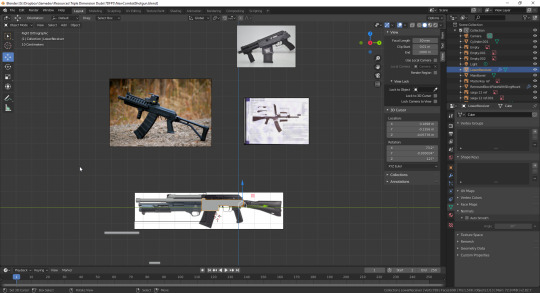
On the bright side of things being on fire, I'm 99.9% sure I can definitely make progress on Jack Schmidt by working on models and designs for things like weapons, regardless of what engine the game ends up going into! Lately, I've actually decided that for the new version of the Combat Shotgun, I'm looking to design it based off of references for the Saiga-12 and Vepr-12, with some special twists and modifications. You can see I've basically started importing a sort of "moodboard" for the weapon into this Blender scene as I work out the design blockout of the weapon. I've also taken a picture of an Akbas underbarrel shotgun and made it transparent to layer on top of an image of the Saiga in order to get an idea of what kind of space I need to use to fit in such an implement to get the planned altfire system to work (for those who haven't heard from when I discussed this on stream, the Combat Shotgun is getting a Half Life inspired altfire that effectively fires twice simultaneously for extreme burst damage; unlike Half-Life, however, it's being "justified" by using a physical modification involving an underbarrel shotgun).
You might notice I'm making an effort to get the modeling of the underlying barrel and recoil piston system detailed enough to make sense; part of that is that there's actually now a plan for the weapon to effectively have two different foregrip designs that are swapped between.
That's because I've made the executive decision to afford myself a little bit of feature creep as a treat. After seeing the mechanic crop up in the likes of Turbo Overkill, I've decided to implement a little bit of a shop system in the game.

It's been a concept I've bounced around in my head quite a bit, especially with regards to the story of the game. The standard introduction is that you work for what's effectively a private military slash security firm contracting company, providing muscle for anyone who provides money. The wacky haunted animatronics terrorizing the (currently) local area are bound to be a civil threat, but you're only specifically there to fulfill a contract from a mildly shady robotics company who wants you to salvage the mechanical and electronic components to do more research on how they are being possessed. This tied into an amusing idea of having "Salvage Value" from Freddy Fazbear's Pizzeria Simulator be a minor mechanic in the game, albeit with a humorously inverted relationship where you'd get bonuses from being even more destructive in your "takedowns" of the Murderbot Mascots.
Thus, implementing a very simplified system for upgrading your weapons and buying other items is a great usage of that concept, and also secretly ends up solving a couple minor issues and tying in neatly with other planned mechanics. For example, one of the things that bugged me about giving the Combat Shotgun this "double-barrel" feature was that it would imply that every Combat Shotgun on the map would also visibly denote that feature, and given that there's supposed to be a generous handful of opportunities for the player to pick up this staple weapon, it's hard to believe that there's this many shotguns with underbarrel shotgun modifications lying around in the world. Therefore, establishing it as an upgrade applied by the player character makes a little bit more sense.
Having a sort of currency system also allows me to create additional hidden pickups as more exploration rewards, too.
The shop system could also be used to purchase additional Burn Chips (the reworked system for powerups going forward). The plan is to limit how many they can buy per level, partly to avoid having them blow all their salvage on consumables and not be able to unlock important weapons and upgrades later on.

#progress and previews#designposting#jack schmidt: murderbot mascots#gamedev blogpost#indie gamedev#long post#yknow ultrakill also had a shop system for upgrades#plus we also have a boss that's just gonna be “we have v2 at home”#we're starting to get dangerously close to straight up having a “style meter” in our game now...
1 note
·
View note
Text
Reading old game dev blogposts and interviews today for games i grew up with and its AAARRRGGHH. I kinda want to program again just so i can make fun little blog posts about a new feature I've been working on that i can then plaster a little screenshot to! But it's been like 7 years since i seriously did anything programming related. I draw doodles now a days and cook for myself. But blogging about that isn't as fun as being like. Woah check out this new rendering function i made it's so wacky! I honestly don't even know what i would make even if i did relearn something like java. Maybe a dwarf fortress type ascii dungeon crawler, but I don't think I can do a project like that in 4 months or so while also not having had any serious gamedev/engine programming in almost a decade!
6 notes
·
View notes
Text
First Post
12/9/2023
Hi, I'm Finian, and this is my first blogpost! I'm really into like every single artform, and my main passion is gamedev! I learned it in highschool, I'm working on it in college, and I hope to make it a career someday.
I'm very critical on myself, and I am very embarrassed to share any art I make, but I've wanted to make a blog for a little while. I think personal writing is fun. I recently received some advice that making a blog might strengthen my portfolio, so I was like "what the heck" and now here I am.
With that out of the way, this post will be about what I consider my first finished game. I did some stuff in highschool, but that was all in a website called code.org. I worked in Unity in my final year, but I served the role of mentor more than developer.
This game was created for my final project in my ENC1143 class, and shall be called my Multimodal Artifact. The assignment was to share what we'd learned over the year in any form of medium we wished, so I made a game. I've only previously done 2D games and I consider myself acceptable at pixel art, so I made a simple 2D platformer. All of my artwork was done in Aseprite and all code was written in Unity, with Visual Studio.
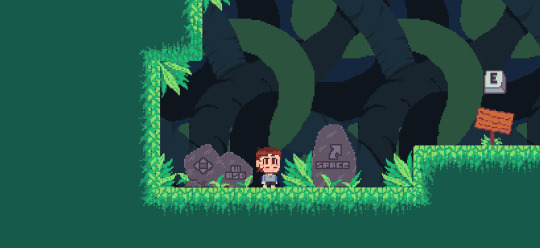
My intentions going into the game were mainly to let the player interact with the sign pictured above, which is something I've never done before. I also wanted the text on the sign to have a scrollbar. I started with an unanimated player sprite, and I made an incredibly simple ground texture, which I stretched to represent a wall. I coded the player's movement and interaction with the terrain. Once I was satisfied with the player's movement, I created some simple animations for idling, running, and jumping.

I then created a tileset of which I am extremely proud, as I've been struggling with grassy and leafy terrain for years. This is the second tileset I've ever made, and the first to perfectly link with itself.

Once I had my tiles in order, I replaced my gaudy primitive, and created the first area of the game as seen in the first image, albeit with significantly less foliage. I created enough level to comfortably house five signs; about half of the game. Finally I began work on the sign itself. The sign was probably the most important part of the game, as its writing is what I was mainly being graded on. There are nine signs in the game, each containing small pieces of the whole final assignment. I created a sprite for the sign in about 20 minutes, and tackled the text with a scroll view. I watched a very helpful video on how it worked, added my TextMeshPro font asset, and made a sign visual behind it all.

My sign was done, from a visual standpoint. I could finally tackle the code, which I did within two scripts. The first script, "Interactable" would be attached to the sign sprite via a child. The script was actually pretty simple, using OnTriggerEnter and OnTriggerExit in tandem with a circle collider 2D to detect if the player was near enough, and an if statement featuring the UnityEvent Invoke in its body. Invoke calls a function from another script, established in the inspector. In this case, I attached a script to the Canvas which disabled and enabled the sign GameObjects.
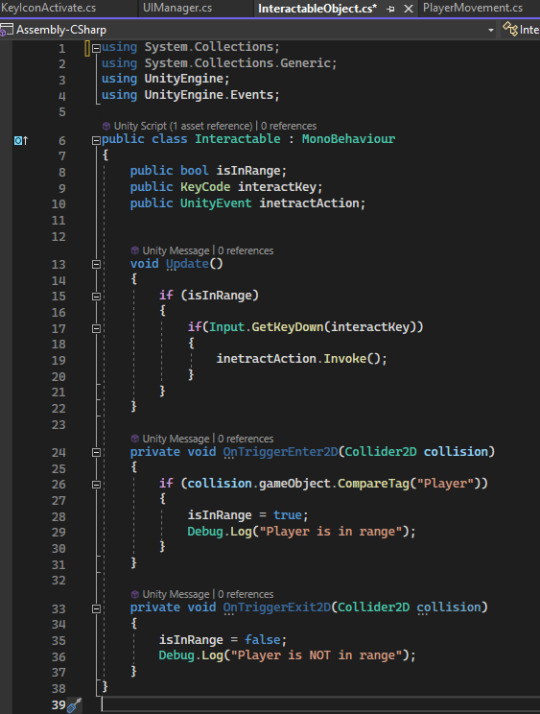
I also added to the sign sprite a key icon, again of my own making, to make sure the player definitely knows what to press. It has an animation which activates when the player walks near the sign.

Both the coding and the visuals for the sign are finally finished! My final steps for this game were: 1) finish designing the level 2) add some scenery 3) if I had time, a pause screen and maybe even a start screen
This was a single-level game, and since it was an english assignment that needs to be graded, I figured it ought to be very linear and very non-punishing. There are no enemies and no dying, so the difficulty had to come from platforming. The player can jump exactly three tiles high and seven tiles far. The game features one six tile wide jump and no necessary three tile high jumps. The first area, already completed features very easy one to three tile wide gaps.
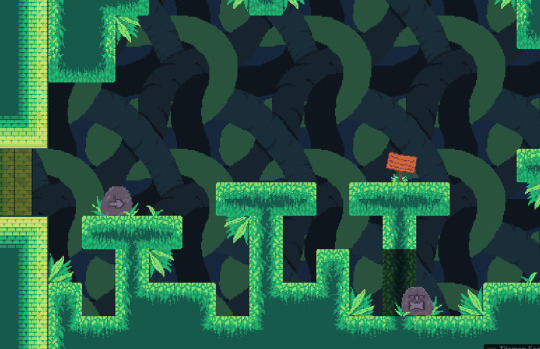
The area has the player go from the left of the level to the right, and eventually upwards and back to the left. Within the first zone, it is possible to fall After every new challenge there will be a sign as the player's reward: after the first jump, , two-tile wide jump, series of one-tile wide jumps (pictured above), series of two-tile vertical jumps, and finally after the first four-tile wide jump. There are some punishing jumps in the upper layer of this zone, which cause the player to lose some progress if missed.
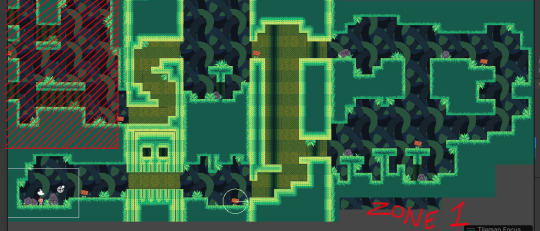
Before making any level past the first sign, I added a second tileset. I took my preciously mentioned first ever tileset, which was a greyish castle brick, and changed it to match my current palette. It's not perfect, but any imperfections are so slight nobody would notice unless they were specifically seeking them out. I added this tileset because I felt continuous jungle would start to get bland, and because I really wanted to get some use out of it. I think it fits in really well.
The second area of my game is a platforming section based off of the loss comic, a suggestion provided to my by my wonderful girlfriend. I think it's a lot of fun to involve others in the gamemaking process, and I think it's fun to work with a specific challenge in mind. I thought of something really fun to do with that idea almost instantly, and got to work.
For those who are unaware, the loss comic is a meme from 2002, which features this character format: I II II I_
I tried loosely to stay within that format, I don't think it tracks very well, but the intention and setup is there.

I wanted my third and final segment to be the most challenging, and I wanted it to be inside of the castle/temple setting, in hopes of making the play subconsciously go "oh, this area is different." Each area of the game has its subtle distinctions, but the distinction here is the least subtle.
The final area features a great deal of wide and high jumps, as well as the first and only head-hitter in the game. In the final set of jumps it is possible to fall back down to the start of the section, and the very last jump isn't very difficult. I think it sucks when you think you're almost done with everything in a game, and you mess up at the very end and have to start all over. I didn't want the player to feel that way, hence the easier last jump.
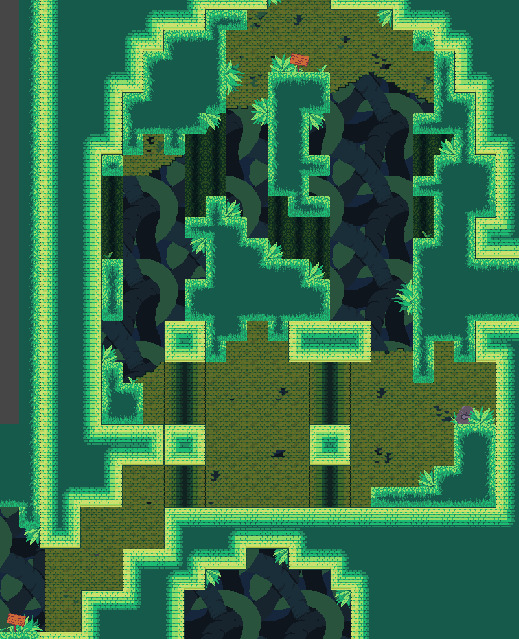
The level was done! My signs (the part I get graded on) were done! I could have some fun with the rest of the game, not that I didn't have fun with the entire previous process, this final bit was just leisure. I love programming.
I started with controls. I put the controls of the game as well as some arrows to point you the right way on rocks, which would not only fit well in the game's environment, but also served well to fill up empty-feeling areas.

After the rocks, I created some bushes. I considered making hanging vines, but I forgot about it somewhere in the creative process. There's obviously not as many of them as the rocks, but trust me when I say these suckers get some crazy mileage. They're everywhere, rotated for the walls and ceiling, flipped, darkened to appear more in the background, placed somewhat behind rocks. These four bushes were super important to the decoration of this game.

After the bushes, I adjusted the hue, saturation, and light of the tilesets to make them appear as background elements. I created the background of the game as a repeating tile. I am not confident in my ability to create a full artpiece, rather than smaller assets, and my wonderful girlfriend added some pixels which I feel made it look significantly better than my rendition. I hue shifted it, and it works excellently as the game's background.
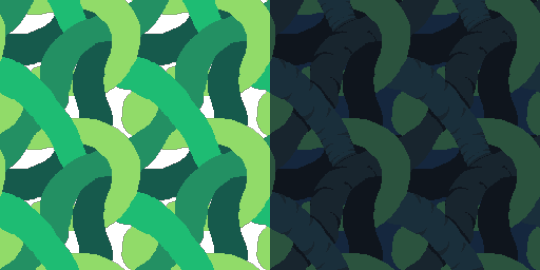
My initial rendition (black was empty) and the final rendition
The final thing to do was to add a pause menu, which is also something I had extremely limited experience with, but found to be super easy. The code is just about the same as making the signs appear and disappear.

The game was not without its bugs, however. There were two that I wanted to fix: 1) sometimes while walking, the player would randomly get snagged and stop. I believed this to be an issue with the ground's collision 2) sometimes upon landing, the player would fly straight through the floor! I also believed this to be an issue with the ground's collision
I had the ground's collider set to a Tilemap Collider 2D, which is a collider designed specifically for tiles. The way a tilemap collider works is that it assigns a square shaped colllider to every individual tile, and would combine all of those collider together in order to save space if it were more efficient on the system. In my game's case it was not more efficient to combine them. However, combining them is exactly what would fix the first issue, the player snagging on the ground. I added a Composite Collider 2D to the tilemap, and viola! No more snagging. The player would still fall through the ground on occasion, but it happened to me so rarely I figured it would be a nonissue. I added a line of code that would set the player's position to the initial spawn if they went too far beneath the map, as well as the reset button in the pause menu which would do the same.
After these fixes I had my incredibly generous roommate playtest for me. He probably played for about thirty minutes, and he relentlessly fell through the map. It was amazing to me how often he just perfectly fell through the ground. Clearly, this was a bigger issue than I anticipated. Thank goodness for playtesters!
After some research, I realized the composite collider actually created an outline of the tiles, rather than completely filling them with collision. The player would fall through the ground because while falling, their velocity would continually increase. Since the collision of the ground was so slim, the player's high velocity would sometimes cause their collider to be on one side of the ground on one frame, and the other side of the ground on the next, not allowing for any collision to happen. The slim outline of the composite collider was not cutting it. There is a setting on the component labeled "Use Delaunay Mesh" which, when clicked, converts the collider from an outline to a full mesh.

The orange lines represent the collider
A Delaunay Mesh is a mesh based on Delaunay Triangulation, which is a complicated math term which can be simplified to mean the mesh has the least amount of big system-taxing triangles possible.
My roommate once again playtested for me, this time with no bugs at all. His thirty minute experience turned into a three minute experience. Magical!
There's more I would have liked to do, but my time ran out and I needed to turn the assignment in. I think I would have liked to make a starting screen, and maybe some hanging vines. If I had as much time as I pleased, I would've added walljumping and maybe some destructible decorations to make the player feel more involved.
I think the game was a success. This is my first game I can say I've actually completed, and I feel proud of how far I've come. If I were to do this again, I'd probably study the games "Getting Over It" and "Jump King," as in hindsight these games were fundamentally very similar.
The end! Thank you for reading my silly blogpost! This took way longer than I thought.
9 notes
·
View notes
Text
instead, Ys I is a game firmly about the world that movement takes place in. by my interpretation, Ys I is a game about travel. there two key aspects of travel, movement and place, align directly with what the game accomplishes. Adol is, after all, a wanderer. and every great story about travel isn't simply about being an external observer, but rather developing close relationships to new people and places.
really really great blogpost on ys 1, kinda forming words (i am unable to) to the things that make this game so enjoyable to me and why it feels so "complete" in a way despite its simplicity in its story/setup
#as someone also playing through ys chronicles - having every npc be named (side effect from trails?) does sooooo much#i like their paragraph on friction too...#ys
1 note
·
View note
Text
Gamedev Blogpost #1: Getting Started
Hello! As this is my first blog post, I thought it would be nice to introduce the main engine I will be using for my current unit of study: GDevelop!
GDevelop is an open-source, 2D and 3D game engine that focuses on easy accessibility and learning for new developers. One of the main differences between it and most other engines is its primary use of blocks instead of full scripting, as pictured below (GDevelop Events vs. Godot Script):


As someone with prior coding knowledge (mainly GDscript in Godot) I've been finding it a little odd to adjust to but I'm getting the hang of it pretty fast. For our first workshop, to introduce ourselves to the program, we were given instructions on how to create a 2D platformer. The first workshop mainly consisted of creating the player character. The player character consisted of two parts: the player sprite + animations and the player behaviours.
For the player behaviour, I selected the PlatformerObject preset, which included basic WASD controls for moving the player and jumping, both of which included their associated properties such as acceleration, maxspeed and gravity. For the player sprite animations, using GDevelops events, I linked the different animations frames with the players actions (i.e idle, walk and jump). The final result of the player character can be seen below:

Overall the process for creating a player character for a 2D platformer was straightforward and easy to understand.
That's all for this devblog, I'll see you all in the next one!
0 notes
Text
Blog #61: The Art of Storyboarding - December 13th, 2022
Blog #61: The Art of Storyboarding – December 13th, 2022
Hey al1! A brief update beforehand. Sovereign Soul: Serpentine Empire is still coming along nicely – more nicely than I could have expected. You’ll be hearing news of it soon, I promise. In the meantime, I’ve been working hard all year to get into the industry of game design. Now, I’m currently part of a new game design company assisting in their narrative design. I’ll talk more about that in…
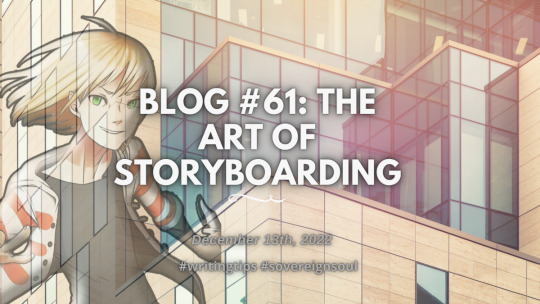
View On WordPress
#gamedesign#Akin Minds#blogpost#d&d#dnd#evernote#figma#gamedev#milanote#Sovereignsoul#storyboarding#writing advice#Writing Tips#writingtips
2 notes
·
View notes
Text
Update
Okay, I think it’s about time I give a small update on what I’ve been doing the past few weeks, what I’m doing now, and what I plan to do in the coming months. I said on Twitter I would make a post about it like a month ago and then of course I completely forgot to actually do it. Anyway, on to the important stuff:
What I’ve been doing:
After the second demo for Knight & Witch back in September I was feeling burned out and frustrated with the game and with myself. I rushed the demo out, in a very buggy and incomplete state, and had to go back to fix it many times before people could actually get to the end. I didn’t have enough time before the deadline, so I skipped playtesting almost completely, which led to a huge number of bugs and just things not working properly.
Even after fixing (almost) everything wrong with the demo from a technical standpoint, the feedback I received was very mixed, and worst of all, I agreed with it completely. Controlling the characters feels clunky and slow; attacks (especially the Witch’s spells) aren’t fun to perform; putting lots of enemies everywhere is not good; a certain puzzle can soft-lock the game if you leave the other character behind; ironically, leaving a character behind makes the game easier because you can stop worrying about them running into traps or getting killed; at the same time, the character you left behind might get attacked while off-screen... The list goes on (and on) but you get the idea.
So anyway, the rush for the demo didn’t pay off and I was feeling down. I needed a break, and I wanted to pursue other projects to kind of relax and take my mind off of it for a while.
So I decided to pick and old project of mine back up: if you’ve been following me for a long time you might remember ColorFall, a mobile game I was working on around 2 years ago. Back then I was close to done but I stopped right before publishing (I’m not completely sure why, maybe I was just bored with it). Anyway, with the programming skills I acquired during this time, I managed to do some major upgrades to ColorFall, starting from refactoring the whole code base to be more efficient, performant and extensible. From there, I went ahead and added some new gameplay features such as special ball types, each with its own effect, implemented online leaderboards and greatly improved the UI design to feel more responsive and ‘juicy’. At this point the game was (and still is) ready to be published, both on PC and Android. The only thing still missing are the sound effects, which I’m waiting for from the same person who I commissioned for the music.
What I’m doing now:
As you can probably guess, working on ColorFall wasn’t really hard or taxing, and it was actually refreshing to get into a project where I could make quick and steady progress, something I had been missing for a while. So in the mean time, I also spent time thinking and thinking and thinking about how to fix the gameplay for Knight & Witch, how to make the combat deeper and more engaging, and just dumping every idea I had regarding the game on a paper notebook I have just for this purpose. Recently, after releasing a game for agdg’s Halloween Jam (SpooQuest), I finally decided to go back and resume work on K&W. Among my priorities, I wanted to finally let the Knight use his shield to guard himself and the Witch from enemy attacks. I don’t have much to show, and in the last few days I’ve been busy with other things so progress is slow, but I think I’m starting to see the path in front of me again.
Also in the last few months I’ve been coming back time and time again to the idea of asking for help to a programmer. But this time it’s different (sort of): now I’m not as non-confident in my coding skills as I used to be. I think I can code all the features I need for my game. However the thing is, I also want to work on the art. So like, I can, and want to, do both things, but obviously this means the game will take a long time to complete. Having a programmer by my side would mean that while he’s coding, I can make models, thus ‘doubling’ the pace of progress.
Anyway you know how it goes, it’s not easy for me to just leave the code-side to somebody else so for now I’m just going to keep working by myself, asking for help only when I need.
What I plan to do next:
Now, what will I be doing in the future? Well, obviously I will keep working on Knight & Witch. I have quite a lot of features planned that I couldn’t implement in the past either due to time constraints or due to my lack of knowledge/skill. I’m feeling slightly more confident now, and the feedback I’ve received with the last demo put me in the right direction I think. As I said above, progress is going slow and the fact that I will be doing it alone, at least in the foreseeable future, means things will take time. A lot of it.
I remember posting my New Year’s Resolutions around a year ago, and I planned to make a ‘real’ game by myself and publish it by the end of 2018. Well, I guess that’s not going to happen. But it’s for the best. A lot of things happened, the scope of the game grew a whole bunch while I was developing it, and for several weeks I had other matters keeping me away from gamedev.
Now with the wall of text out of the way, I will make a follow-up post with images and videos of ColorFall and Knight & Witch to kind of show what changed since my last post here.
There’s also another thing I should talk about, but I’l do so in a separate post to keep things more focused.
8 notes
·
View notes
Link
For every video in my tutorial series about #mobile #gamedev, I make a written summary on my Dev Blog! I've recently summarized Ep. 06 "How to Make an Endless Scrolling Level with Phaser 3" https://browsergameshub.com/endlesscave06-floor-scrolling-mobile-games-phaser3/ 👈
#gamedev#indiedev#blog#blogger#blogging#blogpost#mobile games#mobile game dev#mobile game development#tutorial#programming tutorial#game dev tutorial#game tutorial#game dev#game development#indie dev#indie development#indie game dev#indie game development#html5 games#html5 game dev#html5 game development#android games#android game dev#android game development#games#gaming#mobile gaming#web games#browser games
1 note
·
View note
Text
Spyro Reignited Trilogy
The Spyro reignited trilogy is a great addition that i had been patiently waiting for since the crash bandicoot remaster. The game comes with all 3 classic Spyro games in one. All my favorites remastered in beautiful new textures and graphics as well as some minor improvements such as being able to look and move the camera with the right stick!

This game reignited my childhood so to speak, as i remember solving puzzles and secrets and remembered a time when videogames were video games…. Not so much “live services” as they are starting to become now where you pay for something and the rest of the game content that is on disc is locked behind some paywall. 3 Awesome games on one disc ready for you to collect and explore and fall in love with all over again. It also comes with redone soundtracks of the originals and it just sounds gorgeous even with the ability to switch back to the original soundtrack! I wish they also gave an option to go back in time and see the old graphics with a push of a button.
Playing Spyro again also made me feel old. It’s a weird thing to say but it honestly feels like not long ago that i was only 4 years old sitting down playing spyro on my original playstation and collecting gems, breathing fire on enemies and paying moneybags my gems to access areas and skills. I hope that games like this start to get made again and we remember gamings roots so to speak and that I hope this game inspires a new generation of kids that might look at this in 10 years time and find a new spyro game or something that they can remember and reignite their childhood so to speak!!
3 notes
·
View notes
Link
New dev blogpost! This post discusses how you can give players access to the beta for a new game or an update and what the pros and cons of each method are.
1 note
·
View note
Text
Bossfight month's almost over, where are we at?
The good: We put together a playable Liquid State demo featuring two levels and a bossfight and it's as up-to-date as possible. We got some pretty good feedback on this demo and after polishing it a bit we'll be comfortable showing it around some more. Also, we mayyy have found some songs for the soundtrack. That's a pretty big deal to us.
The bad: We only finished one bossfight in bossfight month.
The update: Hauk and Daniel are headed to Japan next week. I'm gonna stay behind and work on the game. (hi, it's Åge again)

Yeah, so we kinda got distracted and ended up putting together a demo for promo and internal use. It's pretty kickass honestly, the shadows look better than ever and we've done a whole lotta behind the scenes tweaking to make things feel better and we put a lot of effort into between-level dialogue sequences. Overall, working on bossfights took a little longer than expected (even after expecting it to take longer than expected, somehow) and we realized that we had a lot of other work on our plate outside of bossfight work, so we kinda just had to put bossfight 2 on hold for a bit.
It's clear that we need to stay on track and make sure we have a clear sense of direction so we don't get distracted, and I think we just need to think more about why we do the things we do. The next week where the rest of the team's in Japan is gonna give me an opportunity to sit down and think about the gameplay and figure out what we want the end game to feel like. This is also great practice for the rest of the development process where we'll end up kinda scattered around and working on our own.

We still have a lot of work to do, but keeping in mind that we've been stressed out, dealing with personal stuff on the side, and considering the fact that we're three young students making our first game... I think we've done a pretty good job so far.
(Also, side note: The level editor has made it really easy and fun to make levels. I think it was a nice investment!)
Twitter: @vertebraeent Facebook: /vertebraeentertainment Email: [email protected]
#gamedev#gamemaker#vertebrae#liquid state#indie games#video games#devlog#update#hi its age#i wrote a blogpost again#the first pic is a little outdated#it has some skyline visual bugs weve fixed#can't show any pics of the bossfight right now because of -spoilers-
7 notes
·
View notes
Photo

C’est la rentrée après la rentrée sur mon blog ! www.magicfred.com #gamedev #jeuxvideo #jeuxiphone #jeuxandroid #blogpost #microrpg https://www.instagram.com/p/Bn1B6tzBSm_/?utm_source=ig_tumblr_share&igshid=1hza95wf1va7l
0 notes
Link

One of time's most puzzling aspects concerns its ontological status: on the one hand, it is a subjective and relative notion, based on our conscious experience of successive events; yet, on the other hand, our civilization and technology are based on the understanding that something like objective, absolute Time exists. Some philosophers have taken this paradox so far as to conclude that time is unreal; others, accepting the existence of absolute time, have engaged in heated debates regarding its structure, be it linear or circular, bounded or unbounded, dense or discrete. - The Blackwell Guide to Philosophical Logic
Check this post out by clicking the link
#blogpost#blognews#gamenews#gamedesign#gamedev#game#gaming#blog#time#gameplay#play#playing#experience#gameexperience
0 notes
Text
3/30 Blog Post – By Jashua M.
This week, we’re starting to get our combat mechanics worked out. We’re finally at a state where our networking is stable enough to be able to be hosted and joined without a problem. One of us is working on the technical side of the gameplay mechanics, like hit detection, our “tie-breaker” system, input, etc. while I’ll be working on the visual side of the gameplay mechanics, like animations, particles, more weapons, etc. What I worked on this week was our animation system. It’s basically a state machine, like Unity’s, but I like this one a bit better. Basically, I handle the animations by a bunch of bools that represent which “state” of animation you are in, and the machine automatically detects when these bools are being fired or not, and it handles animation transitions. Once those were done on client side, I had to make sure it would replicate for each client in the server. As always, we make an RPC that tells each client that this client is performing an action, in this case it’s an animation. At first I was having issues because on certain clients the animations weren’t firing, and it was because you have to modify the pawn that’s animating for all of the clients. So what this means is, in our own versions of the game, I can’t just say “Hey, I’m playing this animation”. I must tell the server “Hey server, I want this pawn to start animating”, and the server tells everyone else “Hey guys, take this pawn and animate it”. This whole process is weird for me, but that’s how our networking works as of now.
0 notes
Text
BLOGPOST
Apologies for NOT GAMEDEV, but I went see a gastroenterologist regarding my Crohn’s disease for the first time today.
It’s not good. In his words, I “looked like crap”, and I also have a rather extreme case of it for my age (27). I’m to take Prednisone for 3 months, and then one of 4 drugs longterm afterwards (3 of which are injection-based). Prednisone is a steroid. Look at that awful list of side effects, dependency, and withdrawl symptoms, including dementia and mental deficiencies. Yuck.
The worst part is that I have to pay out of pocket because I don’t have a drug plan (thanks Walmart). These are all apparently rather expensive drugs, and I’ve been told the Asacol I was previously taking was apparently not needed as a treatment for Crohn’s after all, which means I’ve probably wasted at least $3,500 on it over the years.
Anyways, I’m not looking for any particular advice, sympathy, or handouts. I just wanted to let y’all know that at some point my game dev will slow down, become difficult, or stop altogether; my posts might become weird or erratic after I start my steroid treatment in a week or so.
Remember to always do your best because you never know what life will throw at you~
8 notes
·
View notes
Text
Tweeted
Check out the blogpost on our build and QA pipeline for #AssembleWithCare! Thanks to @Matt_C_Newcombe for doing a really thorough write-up of it all, be sure to give him some Medium claps! 👏 #gamedev @ustwogames https://t.co/5UeSgB36nU
— Laure 🦝 (@Laure_DeMey) April 9, 2020
0 notes